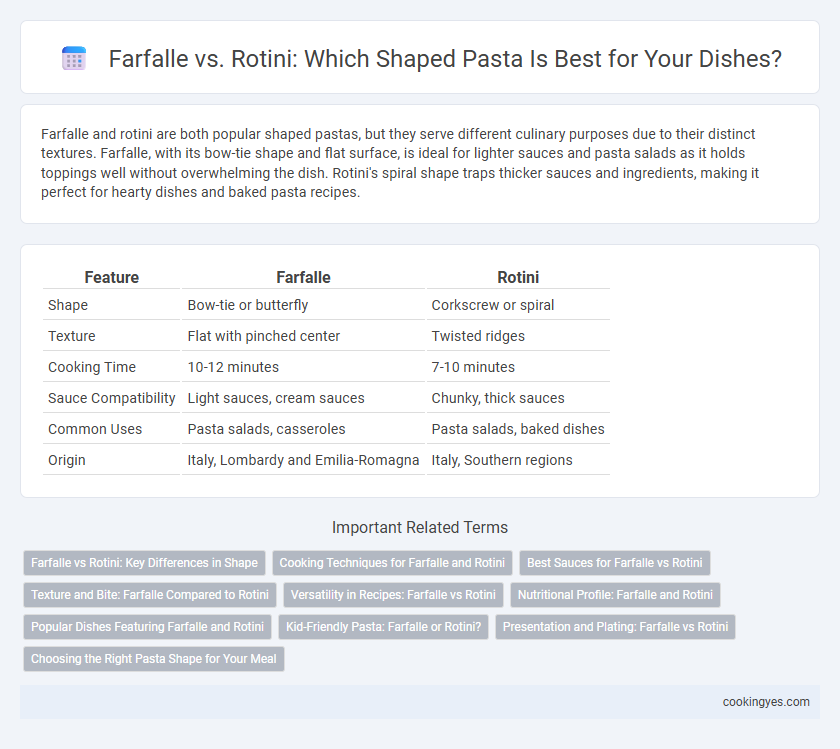Farfalle and rotini are both popular shaped pastas, but they serve different culinary purposes due to their distinct textures. Farfalle, with its bow-tie shape and flat surface, is ideal for lighter sauces and pasta salads as it holds toppings well without overwhelming the dish. Rotini's spiral shape traps thicker sauces and ingredients, making it perfect for hearty dishes and baked pasta recipes.
Table of Comparison
| Feature | Farfalle | Rotini |
|---|---|---|
| Shape | Bow-tie or butterfly | Corkscrew or spiral |
| Texture | Flat with pinched center | Twisted ridges |
| Cooking Time | 10-12 minutes | 7-10 minutes |
| Sauce Compatibility | Light sauces, cream sauces | Chunky, thick sauces |
| Common Uses | Pasta salads, casseroles | Pasta salads, baked dishes |
| Origin | Italy, Lombardy and Emilia-Romagna | Italy, Southern regions |
Farfalle vs Rotini: Key Differences in Shape
Farfalle pasta features a distinctive bow-tie or butterfly shape with pinched centers and flat, ruffled edges, creating large surface areas that hold chunky sauces well. Rotini pasta consists of tight, corkscrew-like spirals that trap bits of sauce and ingredients within their grooves, enhancing flavor absorption in each bite. The primary difference lies in Farfalle's broad, flat shape versus Rotini's compact, twisted structure, affecting texture and sauce retention during cooking.
Cooking Techniques for Farfalle and Rotini
Farfalle requires gentle boiling in abundant salted water to maintain its bow-tie shape and firm texture, typically cooked for 10-12 minutes until al dente. Rotini benefits from vigorous boiling and occasional stirring to prevent clumping, with a shorter cook time of 7-9 minutes due to its spiral structure. Both shapes absorb sauces differently, with farfalle's flat surface best for creamy sauces and rotini's grooves ideal for chunky, thick sauces.
Best Sauces for Farfalle vs Rotini
Farfalle pasta, with its flat bow-tie shape, pairs best with creamy sauces like Alfredo or chunky vegetable-based sauces that cling to its pinched center. Rotini's spiral shape excels at capturing thick, hearty sauces such as meat ragu or robust tomato-based sauces, ensuring every bite is flavorful. Both shapes are versatile, but farfalle complements lighter, creamier textures while rotini enhances dense, textured sauces for maximum flavor absorption.
Texture and Bite: Farfalle Compared to Rotini
Farfalle pasta features a distinctive bow-tie shape with a pinched center, providing a firm texture and a slightly chewier bite compared to rotini. Rotini's corkscrew shape creates a more uniform, tender texture that holds sauces well while offering a smoother mouthfeel. The choice between farfalle and rotini largely depends on the desired contrast of texture and how the pasta complements the sauce in the dish.
Versatility in Recipes: Farfalle vs Rotini
Farfalle and rotini both excel in versatility for shaped pasta recipes, but farfalle's flat, bow-tie shape is ideal for holding chunky sauces and works exceptionally well in cold pasta salads. Rotini's spiral twists effectively trap creamy and thick sauces, making it perfect for baked dishes and hearty casseroles. Their unique shapes complement different textures and sauce types, allowing chefs to select based on desired recipe outcomes.
Nutritional Profile: Farfalle and Rotini
Farfalle and rotini both offer similar nutritional profiles, providing comparable amounts of calories, carbohydrates, and proteins per serving. Farfalle is slightly lower in fiber content, while rotini often contains a marginally higher protein level due to whole grain versions commonly available. Both shaped pasta types are low in fat and serve as excellent carbohydrate sources for energy in balanced diets.
Popular Dishes Featuring Farfalle and Rotini
Farfalle pasta, known as bow-tie pasta, is frequently used in creamy sauces, pasta salads, and baked casseroles, making dishes like Farfalle Alfredo and Farfalle Primavera popular choices. Rotini pasta, with its spiral shape, excels at holding thicker sauces, chunky vegetables, and meats, commonly featured in Rotini pasta salads and hearty baked pasta dishes. Both pastas complement vibrant ingredients but differ in texture applications, enhancing diverse popular recipes.
Kid-Friendly Pasta: Farfalle or Rotini?
Farfalle and rotini both offer kid-friendly appeal with their fun shapes and easy-to-grasp designs, but rotini's spiral shape tends to hold onto sauces better, making it more flavorful in every bite. Farfalle, known for its bow-tie shape, provides a visually engaging option that pairs well with lighter sauces and adds variety to children's meals. Nutritionally, both pastas have similar profiles, but rotini's texture often encourages kids to enjoy meals with chunky or creamy sauces more readily.
Presentation and Plating: Farfalle vs Rotini
Farfalle's bow-tie shape offers a visually striking presentation that complements cream and tomato-based sauces by holding them smoothly on its broad surface, enhancing plating elegance. Rotini's tight spirals trap chunky ingredients and sauces, creating a textured, vibrant appearance ideal for casual, colorful dishes and pasta salads. Choosing between farfalle and rotini depends on the desired visual impact and sauce pairing to elevate the overall plating experience.
Choosing the Right Pasta Shape for Your Meal
Farfalle features a distinctive bow-tie shape that holds thick sauces and works well in creamy dishes or pasta salads, while rotini's tight spirals trap chunky sauces, making it ideal for hearty meat or vegetable-based recipes. Texture and sauce adherence are key factors when selecting between farfalle and rotini, as farfalle provides a smooth bite and rotini offers a firmer, textured experience. For balanced meals, choose farfalle for lighter, more delicate flavors and rotini when a robust, sauce-heavy dish is desired.
Farfalle vs rotini for shaped pasta Infographic

 cookingyes.com
cookingyes.com